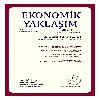TÜRKİYE' nin yılda ortalama %6.5-%8 büyüyebilmesinin ön -koşulları
2030 için beş hedef tanımlandı: (i) işsiz sayısının artmaması, (ii) tarımsektöründe emeğin ortalama-veriminin artması için tarımsal-nüfusun 21.5 milyondan 2030’da dek dört-kat düşmesi, (iii) tarım-dışı sektörde emek veriminin ve küresel rekabet-gücünün artması için yaratılan yeni istihdam başına düşen (alt-yapı ve beşeri yatırımlar dahil) yatırımın (I/ΔL), gereken oranda ve hızda yükselmesi ve (iv) & (v) iki sektördeki istihdamın sektör nüfusuna oranının %28 ve %32’den (sırasıyla) %40 ve %45 civarına çıkması... Bu beş hedefe ulaşmak için, 25 yıl boyunca her yıl tarım-dışı sektörde yaratılması gereken yeni iş-olanağı [(ΔL)t] ve ardından da yapılması gereken minimum yatırım miktarları [(I)t] elde edildi. Bu yapılırken 18 kolon veri türetildi. Türkiye için 2030-hedefleri tespit edilirken, bazı değişkenlerde İspanya’nın 2000 veya 2005 düzeyi; (I/ΔL)2030 hedefi belirlenirken de İspanya’nın 1999-2007 performansının 2030’a projekte edilmesiyle elde edilen sonuç birer kıstas olarak kullanıldı. Böylece oluşturulan beş örnek senaryo çerçevesinde, yukarıda tanımlanmış 5 temel hedefe varılması için gerekli (I)t ve (I/GSYH)t dizileri türetildi. Neticede, tanımlanmış bu beş hedefe varabilmek için yatırım oranının %32-%36 arasına yükselmesi ve tasarruf-oranını şimdikinin iki misline çıkarması gerektiği; aksi takdirde, temel makro değişkenler bazında İspanya gibi bir AB ülkesi ile Türkiye arasında günümüzde var-olan farkların daha da artacağı ve ülkenin ‘yüzü Batı’ya-dönük’ sosyo-kültürel gelişim rotasında kalabilme olasılığının düşeceği sonucuna varıldı.
Preconditions that may enable turkey to attain an average growth rate of 6.5%-8.0%
The minimum annual gross investments including all social-overhead (I)t and investment-ratios (I/GDP)t needed to fulfill the following 5 main targets were calculated for the next 25 years: (i) No new additions to the present number of unemployed. (ii) Agricultural population of 21.5 mln. should decline to about 5.2 mln so as to help narrow the gap between Turkey and EU countries in terms of average productivity of agricultural labor. (iii) (I/ΔL)t --where ΔLt is the annual increase in non-agricultural employment-- should rise at a sufficiently high rate so that Turkey may start catching-up with the EU countries in terms of APL in this sector too and may improve her competitiveness in global markets. (iv v) Employment-ratios in both sectors should rise substantially from 28% and 32%, respectively to 40% and 45%. For this purpose, 14 columns of data were derived to estimate the annual increase in non-agricultural employment needed (ΔL)t so that “target (i)” may be fulfilled. Then the performance of Spain in terms of (I/ΔL)t increases in the 1999-2007 period was calculated and used to estimate the probable range of (I/ΔL)2030 for Spain, which figures were used to set two alternative (I/ΔL)2030 targets for Turkey. The minimum (It) and the (I/GDP)t necessary for the fulfillment of the aforementioned 5 targets for the 2006-2030 period and were thus derived. The results indicated that Turkey must double her present savings rate and increase her investment-rate to 32%-36% or otherwise is likely to face increasing gaps between herself and EU countries in fundamental macro variables such as productivity, per-capita incomes and risk setting on a route that would seriously reduce the probability that Turkey may continue with her “western oriented” sociocultural development .
___
- BAŞARAN, Z. M., (2008), “Avrupa Birliğine Tam Üyelik Sürecinde Türk Tarım Sektöründeki Verimlilik Sorunu: Çalışan Başına Düşen Toprak ile Emek ve Toprak Verimliliğinin Türkiye, İspanya ve Yunanistan Karşılaştırması (1971 – 2004); 25-yıllık Projeksiyonlar, Senaryolar ve Sonuçlarının Yorumlanması”, YÖK Tez Merkezi: http://tez2.yok.gov.tr/tez.htm.
- COUNCIL OF ECONOMIC ADVISORS (2009), The Economic Report of the President 2009, (Ek tablolar) U.S. Govern. Printing Office, Washington D.C., http://www.gpoaccess.gov/eop/tables09.html (Erişim Tarihi: 10.9.2010).
- ÇAKMAN, K. (2008), “Küresel Isınma ve İklim Değişikliği Ne denli Ciddi ve Yakın Tehlike?” Ekonomik Yaklaşım, C. 20, S. 71, 1-36.
- FAO (Food and Agriculture Organization), PopSTAT Dataset, Population Statistics, http://faostat.fao.org, (Erişim Tarihi: Ağustos-Eylül 2010).
- FAO (Food and Agriculture Organization), Resource STAT, Land Statistics, http://faostat.fao.org (Erişim Tarihi: Ağustos-Eylül 2010).
- GİB (Gelirler İdaresi Başkanlığı), http://www.gib.gov.tr/fileadmin/user_upload/VI/GBG1.htm (Erişim Tarihi: 28.10.2010).
- ILO (International Labour Organization) (2006a), KILM (Key Indıcators of Labour Market) 5th Edition.
- ILO (International Labour Organization) (2006b), Yearbook of Labour Statistics, Bureau of Statistics, International Labour Office, Geneva, Switzerland, http://laborsta.ilo.org (Erişim Tarihi: 14.10.2010).
- OECDa, Statistics Library, OECDStats, http://stats.oecd.org (Erişim Tarihi: 18.08.2010).
- OECDb, Stat Extract, http://stats.oecd.org/wbos/index.aspx (Erişim Tarihi: 18. 08.2010).
- TÜİK, İstihdam İstatistikleri, http://www.tuik.gov.tr/isgucuapp/isgucu.zul (Erişim Tarihi: 14.10.2010).
- WRI (World Resource Institute), Earthtrends: Economics, Business and the Environment Searchable Database, http://earthtrends.wri.org (Erişim Tarihi: 24.08.2010).
